Winter 2022 Quarterly Newsletter
| Statewide News | Northern California | Southern California |
Full Speed Ahead for High-Speed Rail in 2022
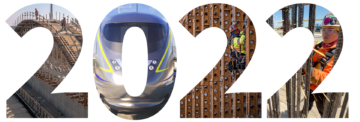
The California High-Speed Rail Authority (Authority) is starting 2022 with plenty of momentum for the California high-speed rail program.
Releasing the Draft Business Plan
On February 8, we issued the Draft 2022 Business Plan, which details the program’s recent milestones, including the creation of more than 7,300 labor jobs in the Central Valley since the start of construction and the environmental clearance of more than half of the Phase 1 alignment. The document also outlines our strategies to harness the historic federal investments in infrastructure to advance engineering and design work, especially in shared corridors in Northern and Southern California. Public review comment for the draft plan is open for 60 days. Following the public comment period, the Authority Board of Directors will provide direction for preparing the final plan at April’s monthly Board meeting. The plan will be formally submitted to the Legislature by the May 1 deadline. The plan is available for review on the Authority’s website.

Moving Forward with Design in the Central Valley
In February, our Board of Directors heard presentations on two Requests for Qualifications for contracts that begin design work north into Merced and south into Bakersfield. These contracts, when issued, are a significant first step towards expanding construction to the full 171-mile stretch between Merced, Fresno and Bakersfield, laying the groundwork for fully electrified, high-speed rail service in the Central Valley with connections to the Bay Area and Southern California. To learn more about these contracts and the pre-bid conference, please visit the Fresno to Bakersfield Locally Generated Alternative and Merced to Madera Design Services Contract pages.
Environmental Clearance in Northern and Southern California
We also continue to take major steps to identify the final route of the high-speed rail system from the Bay Area to Southern California. In January, the Board approved the environmental documents for the Burbank to Los Angeles project section, the first section cleared in the LA Basin. These clearances are an exciting milestone for the program, bringing us closer to providing the first high-speed rail system in the United States. Going forward, we have issued the final environmental document for the San José to Merced project section in February, with the San Francisco to San José project section following this spring for the Board of Directors’ consideration and approval. We are also issuing the draft environmental documents for the Palmdale to Burbank project section this year. All of this work is key to keeping us on track for full environmental clearance of the Phase 1 system by 2023. More about these documents can be found in the regional sections of this newsletter.
Recognizing our Workforce During Engineers Week
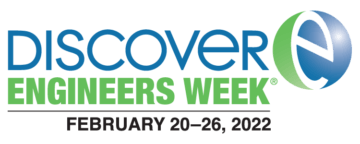
The week of February 20 through 26 was Engineers Week, and it presented us with an opportunity to celebrate the engineers bringing a wealth of experience to projects across the nation while also increasing interest in careers in engineering for future generations. We couldn’t deliver the nation’s first high-speed rail system without the many engineers, representing multiple specializations, including civil, transportation, electrical and environmental, who dedicate their time, knowledge and experience to seeing this project through. As part of that week, we featured videos from Glen Lawson, Gladys Guzman and Sam Singh, who work on the high-speed rail program, on our social media channels.
I Will Ride Brings High-Speed Rail to California Campuses
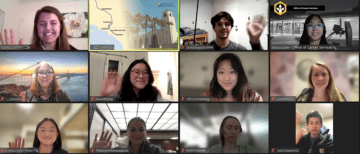
By Yaqeline Castro, Student Outreach Coordinator, California High-Speed Rail Authority
I look at student outreach with a lot of excitement in 2022. We took a highly strategic approach to connecting with students in the last two years, and we’re already seeing things take off this year. Virtual platforms allowed our team to connect with students and build partnerships for student outreach locally, statewide, nationally and internationally. We are bringing the topic of high-speed rail into the classroom, and the conversation is getting good.
We also need to recognize the students that have contributed to the expansion of our student outreach efforts, eagerly and patiently attending virtual meetings and letting us know how we can improve the program.
“I have learned from being in the I Will Ride program that young generations like mine will play a major role in how we reimagine transportation systems to better connect our rural communities with our urban centers throughout California,” notes Andrew Hernon, I Will Ride member.
Andrew is an undergraduate student attending a California State University, still considering a major in engineering or urban planning and regularly sharing his excitement and knowledge of the project at virtual events. Andrew has attended various virtual meetings and events – and we are ready to get Andrew and students like him out to construction tours and networking with our professionals in person.
We already started off the year with lots of activity including a hybrid classroom presentation at Fresno State, a virtual evening discussion at Harvey Mudd College’s Society of Women Engineers, a virtual interactive activity with the Mathematics, Engineering and Science Achievement (MESA) program at California State University, Long Beach, and a virtual webinar to celebrate Engineer’s Week. February is a snapshot of the ranges of activates we are utilizing to reach students all throughout the state.
Looking ahead to March and spring, we aren’t slowing down one bit. Some would say we’re moving at 220 miles per hour. Our first event in the spring is with a great national partner, Introducing Youth to American Infrastructure (Iyai+) for a virtual conference titled The Wonderful World of STEAM, where we will discuss jobs in science, technology, engineering, arts and mathematics at the California High-Speed Rail Authority, followed by our first in-person event at UC Merced with the Society of Women Engineers in their annual Expand Your Horizons conference. To close out the month of March, we will take a group of engineering students from Fresno State on a high-speed rail construction tour. After two years without student construction tours, we’re ready to get them out there again! You can learn more about our student outreach efforts on our website at hsr.ca.gov/i-will-ride or by contacting us at iwillride@hsr.ca.gov.
In addition, we have some exciting updates coming to our student outreach online pages – stay tuned for those coming soon! For now, check out our new page highlighting monthly updates for student opportunities to find internships and scholarships!
| NORTHERN CALIFORNIA NEWS |
Bay Area and Central Valley Leaders Discuss #Valley2Valley
Business leaders from Silicon Valley and the Central Valley discuss the importance of connecting the two regions via high-speed rail.
The panel features Ashley Swearengin, President and CEO of the Central Valley Community Foundation; Jim Wunderman, President and CEO of the Bay Area Council; and Boris Lipkin, Northern California Regional Director of the California High-Speed Rail Authority (Authority).
This discussion comes at a moment in time when the Authority looks to complete environmental clearance that will make the connection between the two regions possible and move the project into the next phase of pre-construction activities—just as new federal funding opportunities are on the horizon.
What’s Happening in Northern California
The California High-Speed Rail Authority (Authority) is anticipating environmental clearance of the San José to Merced project section, just in time for game-changing funding opportunities.
San José to Merced – A Giant Step Forward
Good infrastructure projects start with an extensive assessment of the potential impacts on the natural and human environment.
The San José to Merced project section Final Environmental Impact Report and Environmental Impact Statement (Final EIR/EIS) was released to the public in February, and in April will be presented to the Authority’s Board of Directors for consideration and project approval. This work is performed under the California Environmental Quality Act (CEQA) and National Environmental Policy Act (NEPA).
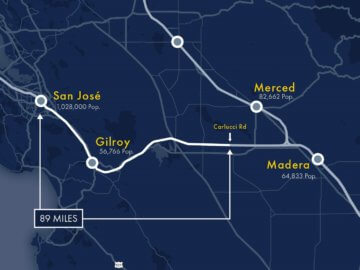 The Authority recommends Alternative 4 as the Preferred Alternative for the San José to Merced project section. Alternative 4 utilizes a blended configuration between San José and Gilroy in the existing Union Pacific Railroad corridor before continuing to a dedicated high-speed rail alignment through Pacheco Pass. This approach minimizes impacts on surrounding communities, reduces project cost, improves safety and expedites implementation.
The Authority recommends Alternative 4 as the Preferred Alternative for the San José to Merced project section. Alternative 4 utilizes a blended configuration between San José and Gilroy in the existing Union Pacific Railroad corridor before continuing to a dedicated high-speed rail alignment through Pacheco Pass. This approach minimizes impacts on surrounding communities, reduces project cost, improves safety and expedites implementation.
If the Final EIR/EIS is approved, the San José to Merced project section will be the first environmentally cleared document for the Northern California Region, moving the project section closer to being “shovel ready”, with pre–construction activities starting as soon as funding becomes available.
Approval of the final environmental document is a key milestone and would be a giant step forward to advance work on the approximately 89-mile project section that will link Silicon Valley and the Central Valley. The Valley to Valley connection will provide a zero-emissions rail link between the two regions, spurring continued economic prosperity and greater economic opportunity for the regional economies.
This summer, the San Francisco to San José project section is expected to follow, providing full environmental clearance in the Northern California Region.
As we look to complete the environmental work for the Northern California sections, the timing may be just right for accessing potential federal funding opportunities in the infrastructure package passed by Congress last November.
Bess Utility Solutions: A Locating Legacy
Beneath our feet, millions of miles of jumbled pipes and twisting cables transport water, gas and electricity to homes and businesses throughout the country.
Digging into the ground can be hazardous, and state-of-the-art technology and expertise are necessary to reduce the risk of hitting buried utilities. Hayward-based Bess Utility Solutions (BESS) is a family legacy rooted in finding and moving underground utilities during the safe excavation of job sites and infrastructure projects.
Jose Bohorquez had aspirations of becoming an engineer at a young age. After graduating from college, he left his homeland of Peru and came to California to pursue the American dream. An entrepreneurial spirit resulted in the purchase of a fledgling materials testing and inspection laboratory.
 When customers requested non-invasive concrete structure scanning, Bohorquez became interested in ground penetrating radar (GPR). At the time, most underground scanning required the use of X-ray devices, and GPR was more affordable and eliminated the need to evacuate a construction site due to radiation exposure.
When customers requested non-invasive concrete structure scanning, Bohorquez became interested in ground penetrating radar (GPR). At the time, most underground scanning required the use of X-ray devices, and GPR was more affordable and eliminated the need to evacuate a construction site due to radiation exposure.
A demand for the technology prompted him to form a second company focused on Subsurface Utility Engineering (SUE) services. Soon, Bess Utility Solutions (BESS) grew into a family business, and Bohorquez’s wife Martha and his sons, Michael, Anthony and Joseph, joined the company. “Since I was 16, I was always involved,” recalled Vice President and CEO Joseph Bohorquez, “We started with just a few people, and now we have over 145 employees.”
Tragically, the family lost Jose to COVID last year. “It was a devastating situation. We miss him every day, but it’s a part of who we are now,” said Joseph.
The company continues to carry on with its mission. “The purpose of our business is to locate and map underground utilities and subsurface structures to protect the integrity, and most importantly, the safety of our community,” stated Joseph. “We are there to use our equipment to locate those utilities and document them so our clients can safely excavate around them.”
BESS has dedicated personnel who provide locating, potholing and surveying services for the high-speed rail alignment from Madera down to Fresno.
“We’re union,” Joseph explained, “We have an excellent training program for utility locators.” The classes provide hands-on training for an assortment of equipment. He added, “Whenever we announce that we’re hiring, it spreads like wildfire, and people from all over come to join our team.”
Marketing representative Diana Layseca went further. “BESS is a certified Small Business, Minority Business Enterprise and Disadvantaged Business Enterprise, and participated in numerous outreach events,” she said. “The outstanding work we delivered and the networking with high-speed rail helps our company stand out.”
As the California High-Speed Rail program presses on, BESS and the Bohorquez family forge ahead with Jose’s locating legacy. “There are many opportunities to help build the infrastructure that’s going to connect different parts of the state,” Joseph concluded, “I am very excited and blessed to be part of this project.”
Read more about other small businesses in the February 2022 Small Business Newsletter.
Frequently Asked Questions
Northern California high-speed rail staff respond to many inquiries from residents, local agencies, neighborhood groups and other stakeholders. Below are answers to some of the more common questions about the program.
Is the Salesforce Transit Center set up for high-speed rail in the future?
An underground train station was built as part of the construction of Salesforce Transit Center. The subterranean station will accommodate track and rail systems for both high-speed rail and Caltrain. The track and rail systems will be installed as part of the Downtown Extension (DTX) project, linking Caltrain’s 4th and King station to the transit center.
What is a Light Maintenance Facility?
A Light Maintenance Facility (LMF) is used for routine maintenance and operations for the California high–speed rail system, including cleaning, servicing and storage. The Northern California LMF in Brisbane will be one of three proposed train maintenance facilities in the state and will serve as a base for operations crew members in Northern California. For more information, please see the Northern California LMF Factsheet.
Have any questions for the NorCal team? Please submit them to us at northern.calfornia@hsr.ca.gov.
Upcoming Events
Here are a few upcoming events in Northern California that you won’t want to miss!
San José Community Working Group Webinar
March 9, 2022
6:00–8:00 p.m.
The Authority conducts outreach events to inform and gather input from local communities, policymakers and stakeholders. Visit the event page for more information.
Morgan Hill to Gilroy Community Working Group Webinar
March 10, 2022
6:00–8:00 p.m.
The Authority conducts outreach events to inform and gather input from local communities, policymakers and stakeholders. Visit the event page for more information.
SPUR: Eliminating Barriers to Common-Sense Transportation Projects
March 31, 2022
12:30–1:30 p.m.
Come explore Senate Bill 288’s impact across California so far and learn about what the future may hold for the law. Click here for more information.
| SOUTHERN CALIFORNIA NEWS |
LaDonna’s Corner

Hello, I am LaDonna DiCamillo, the Southern California Regional Director for the California High-Speed Rail Authority. We are very excited for all the great things in store for 2022 in the Southern California region, and I would like to thank all of you for your continued support and partnership. Our Draft 2022 Business Plan was issued last month, providing an in-depth look at the future for the Authority statewide, as well as a full update from the Southern California region. For questions and to leave comments for the business plan, please reach out to us at info@hsr.ca.gov or visit our website.
Within the next two years, we will strive for environmental clearance to be completed on all four Phase 1 Southern California project sections, setting the stage for advanced design and pre-construction activities to begin while completing construction in the Central Valley. As of January 2022, the Authority Board has provided a Record of Decision on two Final Environmental Impact Report/Environmental Impact Statements for two of the Southern California project sections – Bakersfield to Palmdale and Burbank to Los Angeles. These project sections will close the rail gap between Central and Southern California, dramatically reduce travel time and have multi-modal transportation hubs.
The Authority will continue to work with local partners to develop station area plans based around proposed high-speed rail centers. The Palmdale Transportation Center will feature a Metrolink rail station, a bus hub and a possible connection in the future to Brightline West high-speed rail between Las Vegas and Southern California. The Link Union Station project will transform LA Union Station into a modern transit and mobility hub. Key components include a new platform for high-speed rail, new rail communications, signals and tracks, and run-through tracks over the US-101 freeway to improve efficiency and provide potential one-seat rides to key destinations in Southern California. The Anaheim Regional Transportation Intermodal Center (ARTIC) is a state-of-the-art station featuring Metrolink, Amtrak, regional buses and local transit services, and is considered the first station built to serve California high-speed rail. ARTIC provides easy access to Angel Stadium, the Honda Center and the Disneyland Resort.
2022 is going to be a great year for us in the Southern California Region. We now have a fully staffed communications and outreach team, and we are excited about connecting more with all of you and enhancing our stakeholder outreach. Please visit the Authority’s website at hsr.ca.gov for information on the four project sections in the Southern California region and to sign up for email updates.
Palmdale to Burbank Draft EIR/EIS Release Coming Soon
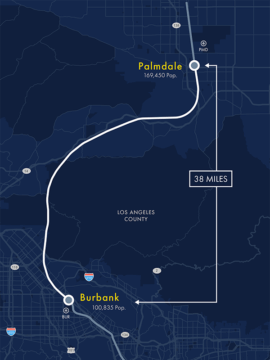
Progress in the Southern California region continues with the release of the Palmdale to Burbank Draft Environmental Impact Report/Environmental Impact Statement (EIR/EIS) coming soon with a 45-day Public Comment Period starting on the release date. This is the third project section to release the Draft EIR/EIS in the region. After publication, the EIR/EIS document can be viewed online at hsr.ca.gov or at a physical location listed on the Palmdale to Burbank project section webpage.
The Palmdale to Burbank Project Section will connect the Antelope Valley to the San Fernando Valley, bringing high-speed rail service to the urban Los Angeles area with a new modern rail line that dramatically reduces travel time between the Antelope Valley and the Los Angeles Basin.
This project section will connect two key population centers in Los Angeles County with multi-modal transportation hubs at the Palmdale Transportation Center and Burbank Airport Station.
These station locations will provide an additional link between the Antelope Valley, the Los Angeles basin, the state at large and the rest of the U.S. through eventual connections to the Hollywood Burbank Airport and other high-speed trains.
Upon completion, the Palmdale to Burbank Project Section will:
- Provide a new link between Central and Southern California and the statewide transportation network;
- Connect the Palmdale Transportation Center to the Burbank Airport Station with an approximately 25-minute high-speed rail trip;
- Provide new opportunities for economic development and connections to many destinations and transportation options;
- Connect high-speed rail to the region via existing and planned Metrolink stations; and
- Provide connection opportunity in Palmdale to the Brightline West high-speed trains between Las Vegas and Los Angeles.
Tunneling – A Statewide Overview of the High-Speed Rail System
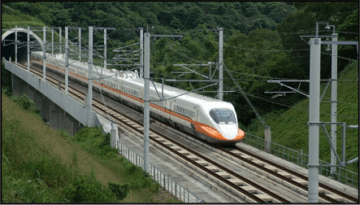
To reduce track distance and provide the curvature needed to maintain acceptable vertical grades and horizontal curvature in mountainous terrain, the California High-Speed Rail Authority (Authority) program will feature 45-50 miles of tunnels between Northern California in the Pacheco Pass and Southern California through the Tehachapi and San Gabriel Mountains.
Two basic configurations are being considered, a single tunnel containing both tracks and dual bore tunnels with a single direction track in each tunnel. The configuration for the Authority’s tunnels depends on factors like alignment, ground conditions, construction method, portal configuration, approach structures, fire and life safety, and operations and maintenance considerations.
The statewide project has three areas where tunneling will take place. The San José to Merced project section has two proposed tunnels in the Pacheco Pass separating the Santa Clara Valley and the Central Valley and will be approximately 1.6 miles long and 13.5 miles long.
The Bakersfield to Palmdale project section will cross the Tehachapi Mountains to close the current passenger rail gap between Central and Southern California. There will be nine short tunnels in this section with a total combined length of 10.8 miles.
The Palmdale to Burbank project section will connect the Antelope Valley with the San Fernando Valley through the San Gabriel Mountains. This section has six alternatives with each requiring tunneling through the mountains and the Angeles National Forest for approximately 22 to 28 miles – depending on which alternative is selected. The Preferred Alternative, SR14A, has four tunnels:
- Two tunnels north of the Angeles National Forest – approximately 13.2 and 1.0 miles in length;
- One tunnel through the Angeles National Forest – approximately 12.3 miles in length; and
- One underground section approaching the Burbank Airport Station – approximately 1.4 miles in length.
Tunnel design requires advance geotechnical surveys and expert analysis which includes preliminary soil, water, subsidence and seismic studies.
Quarterly Newsletter Archive
- Spring 2023 All Aboard Newsletter
- Winter 2023 Quarterly Newsletter
- Fall 2022 Quarterly Newsletter
- Summer 2022 Quarterly Newsletter
- Spring 2022 Quarterly Newsletter
- Winter 2022 Quarterly Newsletter
- Fall 2021 Quarterly Newsletter
- Summer 2021 Quarterly Newsletter
- Regional Newsletter - May 2021
- Regional Newsletter - February 2021
- Regional Newsletter - November 2020
- Regional Newsletter - August 2020
- Regional Newsletter - June 2020
- Regional Newsletter - February 2020
- Regional Newsletter - November 2019
- Regional Newsletter - August 2019
The California High-Speed Rail Authority makes every effort to ensure the website and its contents meet mandated ADA requirements as per the California State mandated Web Content Accessibility Guidelines 2.0 Level AA standard. If you are looking for a particular document not located on the California High-Speed Rail Authority website, you may make a request for the document under the Public Records Act through the Public Records Act page. If you have any questions about the website or its contents, please contact the Authority at info@hsr.ca.gov.



